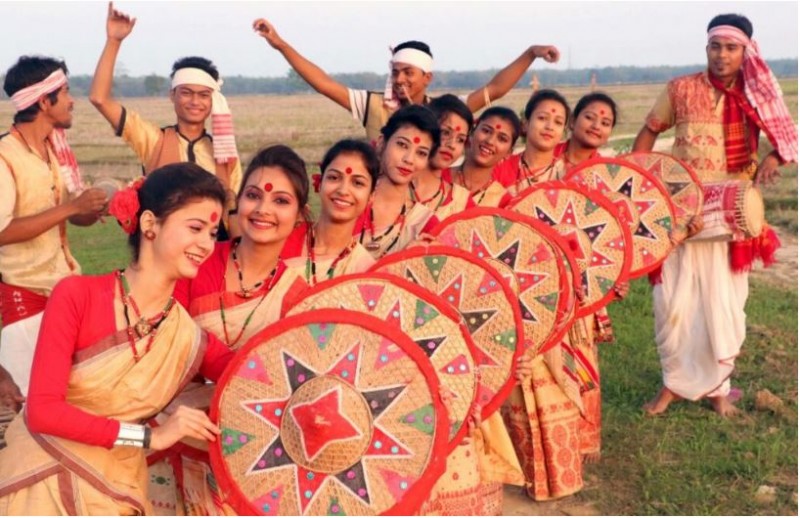
Assam is one of the seven sisters of North eastern states and is known for its picturesque scenic beauty, wildlife, silk, and handicraft and how could anyone forget about the tea. Assam also possesses an exotic culture full of life and the folk dance of the state are no expectation. Assam has different vibrant culture and rich traditional dances.
Few folk dance of Assam:
Bihu
It is the most widely celebrated and popular folk dance of Assam. It is performed during the Bihu festival, which marks the agricultural cycle and the changing seasons. Bihu dance is characterized by lively and energetic movements accompanied by traditional Bihu music and songs. Its colorful and bright costumes make the dance even more extraordinary. The girls look truly beautiful wearing a costume called ‘chadormekhela’ which is mainly made from silk, which is also something Assam is renowned for.The boys’ attire comprises a dhoti and gamocha, a type of turban. They dance to the tunes of various instruments, mainly the Dhol and ‘Pepa’, which is a hornpipe. Its origins can be traced to the districts of Tezpur and Darrang as early as the 9th century. A little-known fact about Bihu is that it was originally a courtship dance and therefore is also considered as a symbol of merriment and seduction. Bihu has managed to create an impact at a global level which is something that we can all be proud of.
Bagurumba
It is a graceful folk dance performed by the Bodo community of Assam. It is usually performed during festivals and social gatherings. The dancers form a circle and perform rhythmic movements, depicting the swaying of the lush greenery and the waves of the river. It is mainly performed by women at the Bwishagu Festival who dance to the tunes of various instruments such as the Serja, Jota, Gongwa, etc. The women are dressed in their traditional vibrant clothing which poetically represents nature.
Jhumur
It is a traditional folk dance performed mainly by the tea tribes of Assam. It is a group dance that portrays the agricultural activities and the daily life of the tea garden workers. The dancers wear colorful traditional attire and perform synchronized movements to the beats of traditional musical instruments. The Jhumar dance has various variations depending upon the occasion. It may be portrayed as a ritual of devotion, as a courtship dance, or as a request to the gods to serve the people with rain and to later thank them for the same. It can be typically witnessed in an open area, with the male dressed in long traditional apparel playing the Mandar which is a type of drum, while the women gracefully execute various movements in sync with hands on each other’s waists. It is truly a refreshing symbolization of the epic highs and lows of just everyday life which is something rarely seen.
Sattriya
It is primarily a classical dance form of Assam; it also has its roots in traditional folk dances. It originated in the Vaishnavite monasteries (sattras) of Assam and is performed as a form of devotion. Sattriya dance includes various elements of folk dance and is known for its graceful movements and expressions. Its origins are traced back to the monasteries called ‘Sattras’ that were set up Mahapurush Srimanta Sankardev for the spread of Vaishnavism during the 15th and 16th century in Assam. The dancers perform to the tunes of Assamese music called Borgeet. Sattriya depicts the stories of mythologies and the lessons learned from them in mainly three themes: Ramdani, Guru Vandana, and Geet Abhinaya. This dance form also stands out particularly because of the costume’s alluring blend of colors which is a perfect representation of the Assamese culture.
Gumrag
It makes the list of one of the most infamous dances in Assam, particularly famous with the people of the Mishing tribe. Gumrag is performed during Ali Aye Ligang festival; it is usually associated with agriculture because of the reflection of its meaning. The word ‘Ali’ means roots and seeds, the word ‘Ai’ means fruit and lastly, the word ‘Ligang’ means sowing. The dance’s said connection with agriculture is the reason it is enthusiastically celebrated by both boys and girls, dressed in traditional clothing with brisk movements, during the Ahu Paddy Cultivation to appreciate our Mother Earth.
Also Read: 5 Most Practice Punjab Folk Dance